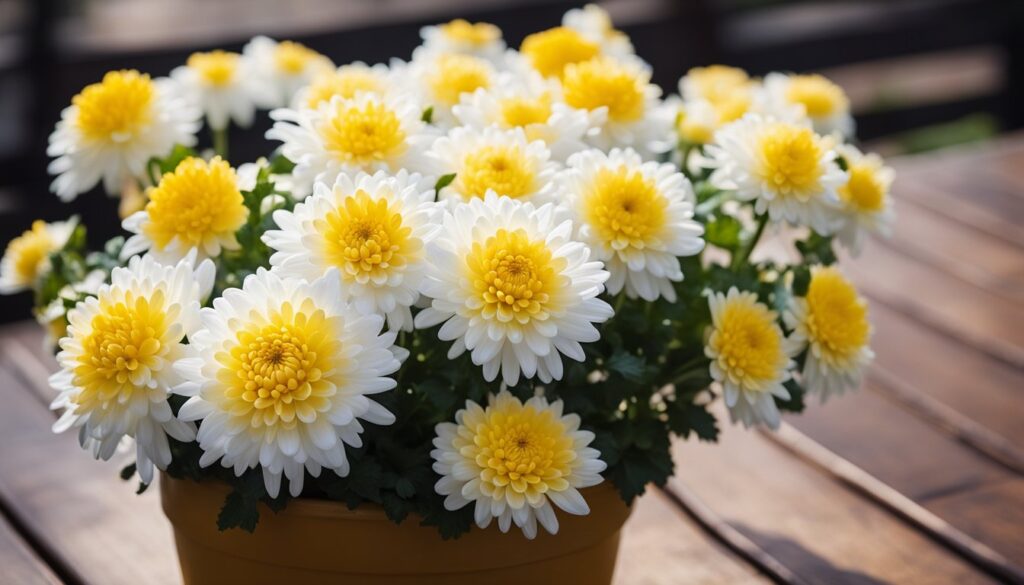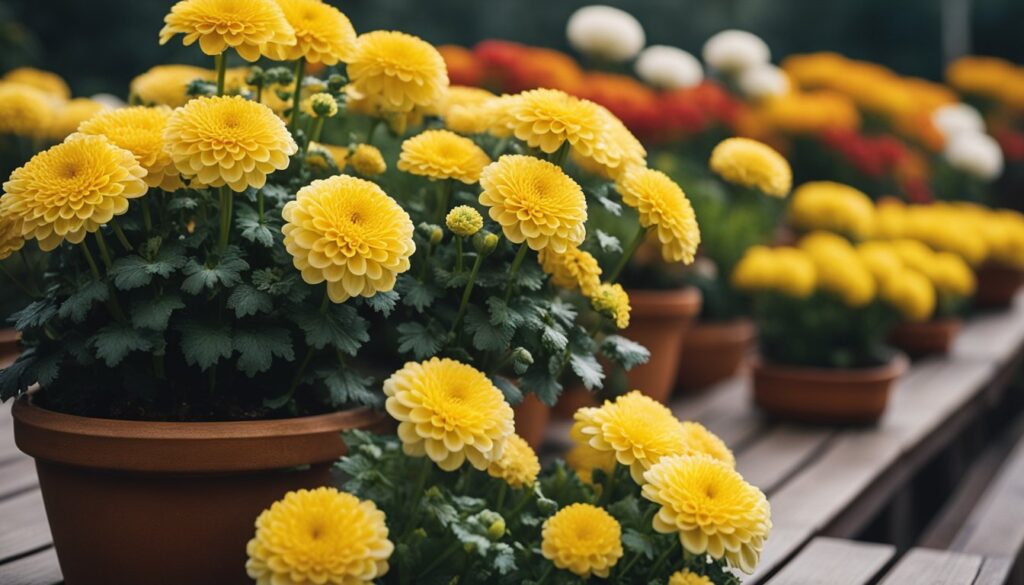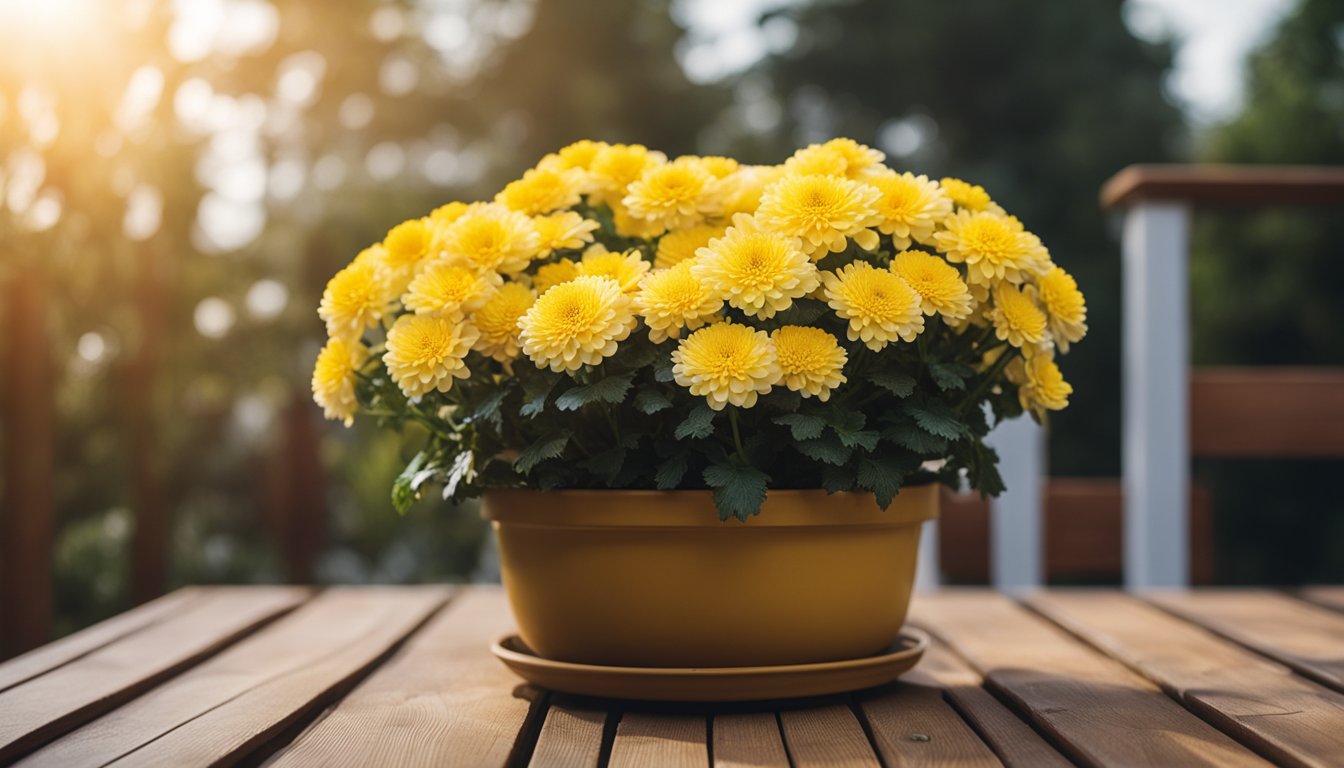Chrysanthemums, or mums as we often call them, are a vibrant addition to any home or garden. Their stunning blooms and variety of colors can instantly brighten up your space. If you’ve ever admired these beauties and wondered how to care for them in pots, you’re in the right place. Caring for potted chrysanthemums isn’t just about keeping them alive; it’s about helping them thrive and showcase their full potential.
Choosing the Right Pots
Choosing the right pots is crucial for the health and growth of chrysanthemums. The right container supports their needs and enhances their beauty.
Pot Size and Material – Caring for Potted Chrysanthemums: A Complete Guide
I always select pots that allow room for roots to grow. A pot with a diameter of at least 12 inches often provides the right space. Material matters too; clay pots offer breathability, while plastic pots retain moisture better. I find that lightweight options work well for easy movement. My favorite choice? A classic terracotta pot that adds a touch of charm to any space.
Soil Requirements

Chrysanthemums thrive in well-draining soil to promote healthy root growth. The right soil mix helps these vibrant plants flourish.
Best Soil Mixes – Caring for Potted Chrysanthemums: A Complete Guide
I recommend a mix of potting soil, peat moss, and perlite. This combination retains moisture while ensuring good drainage. You might grab a bag of pre-mixed potting soil labeled for flowers or create your blend. My favorite ratios include two parts potting soil, one part peat moss, and one part perlite. This mixture keeps the roots happy without drowning them. To keep things interesting, you could also sprinkle in some compost for added nutrients.
pH Levels
I check the pH level to ensure it remains between 6.0 and 7.0. This range supports optimal nutrient absorption for chrysanthemums. You can easily test the pH using a simple soil testing kit. If the soil is too acidic, adding lime raises the pH. For alkaline soil, sulfur can lower it. Monitoring the pH helps maintain the health and vibrancy of my mums. Keeping these plants in their ideal pH range boosts their growth and bloom quality, making every garden look that much more cheerful.
Watering Techniques
Watering chrysanthemum plants in pots requires attention to detail. Proper techniques support their health and vibrant blooms.
Watering Frequency – Caring for Potted Chrysanthemums: A Complete Guide
I check the soil moisture weekly. In the summer heat, I may water twice a week. Pots drain quickly; allow the top inch to dry before I water again. I avoid relying solely on a calendar. Instead, I feel the soil to gauge the need. If it’s dry, it’s time for a refreshing drink. Consistent watering encourages strong roots and blooming throughout the season.
Signs of Overwatering
My chrysanthemums provide clear signals when they’re overwatered. Yellowing leaves often appear first. If the leaves droop, I know I might be giving too much water. Additionally, if I notice fungi or a foul smell from the soil, it’s time to adjust my watering routine. Controlling water levels keeps my plants thriving. Proper attention prevents root rot and other issues, ensuring that my gorgeous blooms remain healthy and vibrant.
Light and Temperature Needs

Chrysanthemums thrive under the right light and temperature conditions. Providing optimal conditions aids in vibrant blooms and healthy foliage.
Ideal Lighting Conditions – Caring for Potted Chrysanthemums: A Complete Guide
Chrysanthemums enjoy bright, indirect sunlight. Place potted mums near a window that receives ample light but shields them from harsh midday sun. Direct light can scorch their leaves, turning them crispy. I often rotate my pots every few weeks to ensure all sides receive equal light. If natural light is limited, using grow lights can help. These simulate sunlight and boost growth, especially indoors.
Temperature Preferences
Chrysanthemums prefer temperatures between 60°F and 70°F during the day. At night, they appreciate cooler temps around 50°F to 55°F. Too much heat can stress the plants, leading to wilting. I keep mine in a well-ventilated area to promote airflow. This helps maintain a steady temperature. When temperatures drop in early fall, chrysanthemums might bloom more vigorously, displaying those stunning colors. Just remember, they dislike frost. When colder weather approaches, I bring my pots inside to protect them.
With the right light and temperature, my chrysanthemums flourish. Their blooms turn my space into a lively tapestry of colors.
Fertilizing Chrysanthemums
Fertilizing chrysanthemums boosts their growth and flower quality. Regular feeding helps them thrive in pots and gives gardens a vibrant touch.
When to Fertilize – Caring for Potted Chrysanthemums: A Complete Guide
I fertilize chrysanthemums every four to six weeks during the growing season. Start in early spring as new growth appears. If chrysanthemums bloom in late summer, stop fertilizing one month before the expected frost date. This timing promotes healthy blooms and prevents excessive leafy growth right before the fall.
Types of Fertilizers
I prefer using balanced fertilizers with an N-P-K ratio of 10-10-10 or 14-14-14. These support overall plant health. Liquid fertilizers work well for potted chrysanthemums because they provide quick nutrient access. Granular fertilizers offer a slow-release option and feed plants over time. I often apply a water-soluble product mixed into water for easy absorption. Organic options, like compost or fish emulsion, add nutrients and improve soil structure. Well-fed chrysanthemums repay my care with a colorful display of blooms, brightening any space.
Pests and Diseases
Pests and diseases can threaten your potted chrysanthemums. Identifying these problems quickly helps maintain their beauty and health.
Common Pests – Caring for Potted Chrysanthemums: A Complete Guide
Aphids love chrysanthemums. These tiny green or black pests suck sap from the leaves. I often notice sticky residue or curled leaves as signs of their presence. Use insecticidal soap or neem oil to control them effectively.
Spider mites also enjoy munching on your plants. They thrive in dry conditions, leaving behind fine webbing as they feast. Increasing humidity levels and spraying water can help keep them at bay.
Whiteflies can flock to chrysanthemums, too. They look like tiny white moths, fluttering around when you disturb the plants. Yellow sticky traps effectively capture them, managing their population.
Disease Prevention
Preventing diseases ensures vibrant flowers and lush foliage. Start by avoiding overhead watering to limit fungal growth. A good rule of thumb is to water at the soil level.
Select well-draining soil to prevent root rot. I prefer mixes that include perlite or sand for better drainage. Monitoring moisture helps too; keep an eye on that soil.
Rotate your potted chrysanthemums regularly. This practice prevents pests and diseases from settling in one place. Fresh air and sunlight do wonders for plant health.
Finally, maintain proper spacing between pots. Good airflow around each plant reduces the risk of diseases. This approach keeps your chrysanthemums thriving and blooming brightly.
Before You Go – Caring for Potted Chrysanthemums: A Complete Guide

Caring for chrysanthemums in pots can transform your space into a vibrant oasis. By following the right practices for pot selection, soil care, watering, light and fertilization, I’ve found that these beautiful plants can flourish and reward you with stunning blooms.
Paying attention to their specific needs not only promotes healthy growth but also enhances their natural beauty. With a little effort and the right conditions, your potted mums will thrive, bringing joy and color to your home or garden. Embrace the journey of nurturing these delightful flowers and enjoy the bright display they bring to your life.
Don’t forget to add theherbprof.com homepage to your favourites so you don’t miss out on future articles.
References – Caring for Potted Chrysanthemums: A Complete Guide
Little Herb Encyclopedia, by Jack Ritchason; N.D., Woodland Publishing Incorporated, 1995
The Ultimate Healing System, Course Manual, Copyright 1985, Don Lepore
Planetary Herbology, Michael Tierra, C.A., N.D., Lotus Press, 1988
Handbook of Medicinal Herbs, by James A. Duke, Pub. CRP Second Edition 2007
The Complete Medicinal Herbal, by Penelope Ody, Published by Dorling Kindersley
Check the Following Article
Delicata Squash Growing Tips: Cultivate a Tasty Harvest
Arugula Indoors: Easy Tips to Grow Greens Year-Round
Sea Buckthorn Oil: Benefits for Healthy and Glowing Skin
Escallonia Plant: A Vibrant Addition to Your Garden
Frequently Asked Questions – Caring for Potted Chrysanthemums: A Complete Guide
What are chrysanthemums, and why are they popular?
Chrysanthemums, commonly called mums, are colorful flowers loved for their vibrant hues and ability to enhance gardens and homes. Their stunning appearance and variety of shapes make them a popular choice among gardeners.
How should I care for potted chrysanthemums?
To care for potted chrysanthemums, provide well-draining soil, adequate sunlight, and consistent watering. Monitor soil moisture and avoid overwatering to prevent root rot. Fertilize regularly during the growing season for optimal growth.
What kind of pot is best for chrysanthemums?
Choose pots with a diameter of at least 12 inches, allowing room for root growth. Terracotta pots are preferred for their breathability and charm, while plastic pots retain moisture better.
What soil mix is ideal for chrysanthemums?
A good soil mix for chrysanthemums involves two parts potting soil, one part peat moss, and one part perlite. This combination retains moisture while ensuring excellent drainage and root health.
How often should I water chrysanthemums?
Check the soil moisture weekly. Water when the top inch of soil feels dry, avoiding overwatering, which can cause yellowing leaves and root rot. Adjust watering frequency based on the season.
What light conditions do chrysanthemums need?
Chrysanthemums thrive in bright, indirect sunlight. Rotate pots regularly to ensure even light exposure, enhancing growth and blooming. Protect them from frost for optimal results.
What is the ideal temperature for chrysanthemums?
Chrysanthemums prefer daytime temperatures between 60°F and 70°F and cooler nighttime temperatures of around 50°F to 55°F. Maintaining these temperatures promotes vibrant blooms and healthy foliage.
How often should I fertilize chrysanthemums?
Fertilize chrysanthemums every four to six weeks during the growing season, starting in early spring and stopping one month before the expected frost date. Use a balanced fertilizer for best results.
What pests and diseases affect chrysanthemums, and how can I manage them?
Common pests include aphids and spider mites. Use insecticidal soap or neem oil for control. To prevent diseases, avoid overhead watering and ensure good airflow around the plants by maintaining proper spacing.

